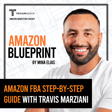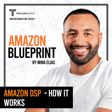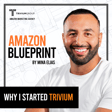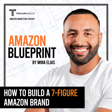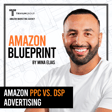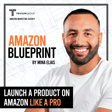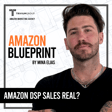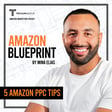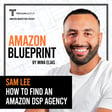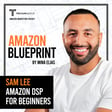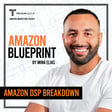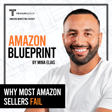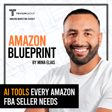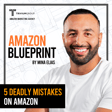Become a Creator today!Start creating today - Share your story with the world!
Start for free
00:00:00
00:00:01

Tariffs Ruined Amazon Businesses - SOLVED
Tariffs are crushing Amazon sellers in 2025 — but there’s a way to beat them.
In this in-depth Amazon masterclass, I sat down with Isaac Hetzroni (global sourcing expert) and Ephraim Ausch (logistics & shipping pro) to break down how top sellers are adapting to the new China import tariffs and rising duties.
Whether you're an Amazon private label brand, a 7-figure seller, or scaling an ecom business — you need to hear this.
You’ll walk away with real strategies to protect your profits, optimize your supply chain, and grow.
Need help with Tariffs? Get a FREE account audit to see how we can help: https://hubs.la/Q03kQhnP0
Transcript
Introduction and Acknowledgment
00:00:00
Speaker
Welcome back to the Amazon Blueprint Podcast.
00:00:05
Speaker
Dude, people are hurting right now. And I know you guys have pretty much solved. Like there's at least five ways to get around this. So I'm like really excited to hear them. Happy to be on there with you and try to help everyone as you know, everyone everyone's going through this crazy time.
00:00:18
Speaker
Amazing. So let me introduce you guys real quick.
Introduction to Tactical Logistics
00:00:21
Speaker
Let's start with Evraim. Evraim and i are ah very good partners. Evraim owns Tactical Logistics. I've sent Evraim a ton of business over the years. We've been friends for like over five years. He is the most trusted third party logistics company we have. And then Brandy actually and I launched a women's brand in a really, really tight spot and he came in and like saved the day. So super trusted, Efrem, do you want to give a quick intro?
00:00:44
Speaker
Sure. Hey everyone, it's nice to meet you all. I'm Efrem Aush, Chief Logistics Officer for Tactical.
Efrem Aush's Background and Role
00:00:50
Speaker
My background is Amazon sales. So I've been a seller from 2011 till 2017. And then I joined our family business. My dad started Tactical and then I came in seven years ago and became a partner there. So what we're focused on is just helping mainly e-commerce, Amazon sellers grow on Amazon.
00:01:09
Speaker
And we take care from the back office stuff, the boring stuff of logistics and all that. So we handle A to Z where we import product, clear customs, warehouse it, and then drip feed into Amazon or anything in between flexibility wise.
00:01:22
Speaker
And fun fact, Brian has a warehouse in l LA, in like near Long Beach. He invited me to like a Christmas party. And I came over, and he's just giving away a bunch of free products to everyone. Because it's like the products that get returned, and they don't want them anymore. Like the people don't want to sell them. And it was just, dude, it it was like he was like Santa Claus, just giving away gifts to everyone. It was so funny.
00:01:42
Speaker
Yeah, we have this thing that every time ah customer does a removal order or they decide they're discontinuing a SKU, instead of throwing in the garbage, and we keep it for our Christmas party and then we do mystery gift boxes.
00:01:53
Speaker
So you have these huge boxes full of stuff. Some stuff are good, some stuff are garbage, but everybody gets like a mystery gift box. Nice.
Isaac on Strategic Sourcing
00:02:01
Speaker
And then Isaac, Isaac and I met recently, Isaac is the sourcing guy. Right. And so like we started talking and I was like, tell me a little bit more. How do you source? So this guy was literally born into sourcing, like his, his parents owned a manufacturing facility.
00:02:14
Speaker
So he was literally born into the game. And when we started talking about like his sourcing strategies and like how he goes about it. it was honestly like very very interesting and very refreshing like super strategic like the stuff he was saying i haven't heard anyone else like most sourcing companies they're like sure we'll go talk to a bunch of manufacturing companies in china isaac was actually talking to me about like the labor pool in different countries the manufacturing capabilities in different countries the native raw materials in each countries and so like a very strategic way of thinking about sourcing way beyond, oh like let's talk to 10 companies and see which one has the best quality. law Like this kind of, you know, how everyone does it.
00:02:50
Speaker
So Isaac, I'll let you also give a quick intro on yourself. For sure. Thanks, Amina. So yeah, I'm Isaac, the sourcing guy, running a product sourcing agency for about eight, nine years now. And our whole thing is we help people source products from the best factors all around the world.
00:03:04
Speaker
um I kind of saw a lot of this happening, like right after COVID, I was like, okay, We have to really divest our supply chains and build supply chains around the world. So I went and I traveled for a year straight, just visiting factories all throughout Southeast Asia, through La Am, through Europe.
00:03:19
Speaker
I was able to get really strong understanding of the global supply chain. So that's why I'm excited to be able to talk about this now, because if you do need to move your manufacturing outside of China, that that's going to be part of your tariff strategy.
00:03:31
Speaker
There are a lot of small things you to understand about each country and then how to execute there. So yeah, thanks for having me. Awesome. Awesome. Okay, let's get right into it.
00:03:42
Speaker
You know, I think everyone's here now. Guys, again, if you have any questions about sourcing, put them in the Q&A. We will answer as many as possible. I want to get right
Tariffs Impact on Manufacturing Costs
00:03:50
Speaker
into the meat. Like, I don't want f*** around, right? So we can talk about moving manufacturing to a different country and all this s*** later on. I want to start with like the sexy stuff. So right now I'm manufacturing in China, right? And so I'm paying $10 unit for my shit.
00:04:05
Speaker
The tariffs came on. Potentially I'm going to pay $25 per unit for my shit. This is going to destroy my business. I'm not going to have a business anymore. I don't even have $15 profit per unit after PPC. So Isaac, let's start with you. What's one thing I can do right now if I'm sourcing in China and my shit's already in China, like production runs are going to avoid going from 10 to 25 cost of goods, which at that point, there's even no point of me even bringing it to it to America. Like I can't sell it. You know what i mean?
Shipping Terms and Cost Reduction Strategies
00:04:29
Speaker
Yeah, I mean, that's that's the main issue, right? Is it does not make sense for you to go and ship the product right now. The honest solution is you should probably slow down and not make any really jumpy decisions.
00:04:40
Speaker
Try to really evaluate. So some small little things are going to be, if you want to save just a little bit of money, right? You could switch over from FOB terms to Xworks terms. So what that looks like is your taxable value.
00:04:52
Speaker
So you wanted to figure out how you can lower the unit costs of the product as much as possible. Now, there are... probably after that, you don't want to just go and try to lower your cost of goods from 10 to four. That's unrealistic, right? But understanding as an example, X works in FOB, you're paying for the goods to go from the factory to get onto the boat and that cost basis.
00:05:14
Speaker
shouldn't really count towards your actual manufacturing cost of the product. So you can switch over to those different eco terms. And that's just kind of like a larger conversation that we're going to be having about how can we potentially lower the taxable rate on the product? Additionally, right we're going to be talking about, you know, what are your options right now? How can you be nimble? How can you be fast in regards to once policy does change, being able to go and, you know, make moves and a lot that's going to be, you know, either having a product ready or moving the product already into like a bonded warehouse, right? Either in the U S or yeah near shore. Yeah. We'll talk more about that later. So let me pause there, right? Because I want to break it down even further for everyone. So guys, there's three ways you can get the product from the manufacturer to America.
00:06:00
Speaker
Number one is X-Works. X-Works means they're going to manufacture it and they're going to leave it at the door of the warehouse. You are responsible, you know, contact someone like a fry, responsible to go pick it up and take it to America. The second one is FOB. FOB means they're going to go from the manufacturer to the boat. And then it's your responsibility from the boat to America. So if right now you go and you look at your invoice, if you if it's already X-Works, we'll talk about it in a second. Okay. But like if it's FOB, right? And so right now it says you're paying $10 cost of goods for FOB. So from made and shipped to the, put on the boat, you can say, okay, change it to X-Works.
00:06:34
Speaker
And they'll say, okay, cool. It was $10 with FOB, with the delivery to the boat. Now it's $6 because four of that dollars, we were upcharging the transportation for you. So now you cut down your cost of goods, right? By $4. Now, realistically, the manufacturer is not going to like that. They're not going to be like, oh, cool. Yeah, we'll cut you from 10 to four.
00:06:56
Speaker
You know, technically, like they'll probably cut cut you from 10 to nine maximum or nine nine and a half, if that, right? you can say, listen, cut me from 10 to six, right? And then that extra difference, right, which is XWorks FOB difference, it's actually true cost of goods. Can you invoice me separately for something else related to services? So you're paying for services to cover the difference.
00:07:16
Speaker
But then your cost of goods went down. So now you're going to pay duties and tariffs on that cost of goods, the $6 as opposed to the 10, but you're still going to pay the 10 cost of goods, all of it to the manufacturer, but it's just going to be broken out. Six is going to be what's going to show up on your commercial invoice. And then four is going to be services rendered to the facility. Ifram, can you comment on that? And by the way, full disclaimer here, you need to have an attorney involved in this process. They need to sign off and say like, this is above board. And if you get audited, like everything's gonna be fine. But Ifram, can you comment on that whole
Challenges with Changing Shipping Terms
00:07:48
Speaker
process? Sure.
00:07:49
Speaker
So it's a regular legal term to do X-Works. I mean, a lot of people do X-Works terms. There's nothing wrong with doing that. I mean, to say on my end, it's the same thing for me. mean, it says like, or the supplier is paying me for the manufacturers paying me for the origin charges, whatever happens at origin, or it's the customers paying for me for it.
00:08:07
Speaker
So for me, it doesn't make a difference, but for a commercial invoice, it makes a difference. Okay. but So the product is going to be lower. Yeah. And then are you seeing any issues with the commercial invoice changing?
00:08:18
Speaker
Because if it was before XFOB, after YX works and X works is significantly less. Are you seeing any issues with the commercial invoice? Not when you change terms, but when you change, you have an FOB commercial invoice. Now you negotiated your supplier and he gave you, let's say a 20% discount. It's a little bit, that's a little bit higher risk. We had a customer that like for six years, he brought on a product that let's say $2 a unit.
00:08:41
Speaker
And he negotiated with a supplier that he's going to start paying $1.50, same FOB. All the shipments got flagged because they see it in their database. Hey, this guy paid $2 till now. What drastically changed now?
00:08:52
Speaker
But if the terms changed, it's legitimate. Yeah, again, even if they flag it, they'll release it. They'll check it out, release it. It's just extra time wasted and extra cost because they charge you money for the exam. and They charge you money. The trucker has to take it from the port to the exam site and pick it back up.
00:09:07
Speaker
So it's extra cost, unnecessary cost, and it delays. It could take sometimes, regular exam takes a week, but intensive exams could take two weeks, three weeks. I mean, now things are getting a little bit more backed up with these type of things with a little bit more on top of things. It might take longer. So I wouldn't try to risk it that way.
00:09:22
Speaker
But when change terms, i don't I've not seen that happen. Okay, amazing.
Cost Separation Strategies for Tariff Reduction
00:09:26
Speaker
So changing terms keeps you under the radar. And again, the way we're talking about this is when you change the terms, in reality, you will probably not get a ah big discount. But if you talk to your manufacturer and say, we need to change terms, we'll still get you paid, but it's going to be differently. It's going to be, I want a lower cost of the goods and I will pay you a service fee. Because in reality, this is not illegal or illegitimate. They are in your cost of goods, burying a bunch of services.
00:09:54
Speaker
Right? So they're taking raw cost of goods, services rendered, merging them and giving you your commercial invoice. Say, listen, separate this out. Like if you're charging me for QC, R and D molds, et etct cetera, et cetera, et cetera, which they are right. Because they incurred that cost to make your take it out. I'll pay that separately. Cause it's not actually the raw cost of goods required.
00:10:15
Speaker
And then if you're changing from FOB to X works or vice versa, that is a significant change. Now, can I play a, just, that you know me, I like to push the envelope a lot. Can we make a small adjustment to the product? So right now I have, you know, my product, right?
00:10:30
Speaker
Make a small adjustment enough that it's fine to use the same ASIN on Amazon, but then tell them create ah a brand new. So now you don't have a track record. You don't have a history. So I was buying a $10 product from you. Now I have a new product from you that is $5 only, but it's slightly different. So it still will work for the same ASIN and same UPS. I can still send it to Amazon or are they tracking it on a UPC level?
00:10:52
Speaker
It's a database, it's a system. So if this is a brand new SKU on a commercial invoice that they don't have any data on it, for them and their, in the system's eyes, it's like brand new. Perfect. Guys, so go into your Amazon inventory, right?
00:11:05
Speaker
Go to the listing, click on it, do create a new condition. that will create a new SKU under the exact same ASIN. So I do this when I change manufacturers. I have SKU1, which is manufacturer one, and then SKU2, manufacturer two, because I don't want to mix both of them in the same one.
00:11:21
Speaker
And then use the FNSKU. I suggest using the FNSKU because it's going to be the same UPC code, which could potentially trace back. But if you create an FNSKU and you label FNSKU,
00:11:32
Speaker
Now there's no trace. It's tracked through the FN SKU and it's technically a brand new product. So if your price all of a sudden goes from 10 to six or five, and again, you negotiate with the factory and you say, hey, listen, I'll pay you five raw cost of goods and the other five that I was supposed to pay you, I'll pay it as a service fee. for your services, you know, a factory services, whatever.
00:11:53
Speaker
I think that should be fine. And then in exchange, you now have a new product, no history. They can't flag you as, Oh, you cut your costs by 50% potentially trying to avoid the tariffs. Yeah. I want to really clarify it here. I think that there's different ways to look at the cutting of the costs and it's important to specify. So this is, if we're talking about a product that has significant R&D, significant mold, significant complication like complexity within the product. And that there are true development in R&D costs that you were paying for that the factory is looping into the product costs. If we're talking about making a basic cotton t-shirt and you're going and trying to reduce like cost basis by claiming $200,000 R&D costs, fly.
00:12:35
Speaker
that isn't going fly Right. This is only like, if the factory is looping in all these product costs into, into the actual piece, then you can ask the factory how they're essentially breaking that down. And yeah, and then you can work on it on on a new product and also just making changes to the product.
00:12:51
Speaker
So it's not just about like what's on paper. It's like can you actually go and lower the cost basis on products? I mean, we hate saying lower lower quality, but maybe that's what you need to do right now.
00:13:02
Speaker
Slightly change your product, use different materials. use different manufacturing process to go and get that product cheaper, at least for the short time being, if you are trying to go and really mitigate these tariffs.
00:13:14
Speaker
Isaac, let's like run some math here, right? So let's assume that the worst case, which is the 10 becomes 25, right? So let's say acceptable for me, I'm okay to let it go to 15. So 10 becomes 25, five becomes and a half.
00:13:27
Speaker
six becomes almost 15. So I would need to go from 10 to six, right? And so that's a 40% reduction. That's my target. And that's still, I'm going from 10 to 15. That's still hurting my bottom line. Ideally trying to go from 10 to maybe 11 or 12 max, right? So I'm trying to actually reduce my cost basis from 10 to five. So that's why when I, Talk about this stuff like, you're right, if it's a cotton shirt, you're super limited, but if it's a cotton shirt, I'm just gonna create a new variation of the cotton shirt that's brand new skew, and I'm gonna tell them, hey, let's negotiate. Either I'm not gonna give you any business, or instead of charging me 10 for the cotton shirt, you charge me five for the cotton shirt and $5 a unit for renting the machine.
00:14:08
Speaker
And I'm instead of manufacturing with you, and I'm now renting the equipment and renting the labor. And- Mina, it's a gray area. It's too gray. It's, it's too very gray. I wouldn't, I wouldn't recommend this to anyone necessarily.
00:14:21
Speaker
Like you gotta talk to your lawyer, talk to your lawyers. Like, yes, like in theory, it's great if you can, but every product's gonna be different. And like, you know, they're going to be cracking down. There's history. There's no history.
00:14:33
Speaker
But the thing is, is yeah. So there's no history at least for now. So like you're going to import the product and it might clear, but then if you get audited down the road, are they checking HS codes and comparing HS codes or what? Well, they're going to, what they're going to do is that they're going to audit at you and they're going to be looking at what was this other payment for 50% of the cost, cost of goods or a hundred percent of the cost of goods to this factory. And you're going to say, Oh, it was for Z. And if it doesn't,
00:14:59
Speaker
make sense if it's clearly a strategy to go and like mitigate tariffs, then they're gonna get, you're gonna get in trouble for that. god But if it's if it's truthful, like, oh no, like we just paid our mold costs directly, you know, instead of baking it in. Okay, let's separate.
00:15:12
Speaker
And guys push a lot of that to the manufacturer. Tell him, listen, like I want to create a scenario where My raw cost goes from 10 to five. And the other difference, I mean, either give it to me as a discount or else you're going lose my, at least you get $5 from me versus you get nothing from me. And you're still, your labor is there. Still your, your factory is there. Still everything is there.
00:15:31
Speaker
So it's, at least I'm going to keep your lights on. And they know that. They know, okay, like Isaac, I want to touch on your dad's factory like a little bit in a second, you know, kind of how you used to do that, keep the lights on type of thing. But let me, I dont i want
Benefits of Using Bonded Warehouses
00:15:42
Speaker
to keep moving, right? So both of you guys hinted to something. Wait, we think things are going to change, et cetera, et cetera, et cetera.
00:15:48
Speaker
So let's talk about bonded warehouse. What a bonded warehouse is and the strategy of like, okay, you've already manufactured. There's no going back here, sending it to a bonded warehouse, keeping it there. And then let's say like Trump says, okay, I'm going to open it up for 30 days. But boom, you send your during those 30 days into the us and now you're good to go so can you talk to us about this yeah so bonded warehouse is basically a warehouse that's surveillance by us customs it has a bond on file it's an expensive bond but it's a it's a bond basically we don't have one but if it would be basically in a warehouse it's a gated area it has to be surveillance 24 7 and then you have to have a serious bond on it based on i believe the value of goods uh what's in there what it helps an amazon seller or
00:16:32
Speaker
a person that imports goods by being in that warehouse is that you not have to clear customs as long as it's sitting there. So we have certain companies that do it all year round where they want to watch on their cash flow. So as they take out goods from the bonded warehouse, that's when they clear customs, that's how they pay duties.
00:16:48
Speaker
instead of paying duties in the whole container one shot and they'll pay it gradually especially now where everybody's trying to avoid these crazy tariffs and everybody wants to wait but they want to have their product here or a product already left it was too late to bring back all these type of scenarios is where people need a bonded warehouse and it's expensive it's not cheap the store there it's not a cheap option but at least it's cheaper than 145 tariffs sure That's why a lot of people, a lot of people are taking stuff to Mexico. A lot of people are taking stuff to Canada where they're holding it as holding areas. And then once tariffs gets lower, they'll try to import it back in the US. So it's one of the ways how to delay the tariff.
00:17:26
Speaker
and hope for that it's going to come down. It seems positive that things will change, but it's a waiting game. All right. So let me put this into more actionable form, right? So if you just manufactured, you have a certificate of origin and a commercial invoice, and it says $10.
Maintaining Stock Levels on Amazon
00:17:41
Speaker
We can't fuck around with that. I mean, you could still, you could go negotiate and say, hey, like, can we change up this invoice?
00:17:46
Speaker
But let's say you can't, let's say it's it's too late now. So you ship it to Mexico, you ship it to Canada, or you ship it to a bonded warehouse, where if it's in those places, it still has not paid, it still will has not crossed the border of the US, and so it does not have to pay tariffs. And so you hold it there.
00:18:02
Speaker
Now, if you're running out of stock on Amazon, you're kind of out of options. I would rather you, as someone who's run over like 190 brands in the last 12 months actively, i would rather you lose a lot of money and stay in stock because if you run out of stock, trying to get back that momentum is gonna cost you way more than the tariffs. I guarantee you that. So just say it, you've been making profits, bite the bullet, get it in, keep staying inventory while you're planning these other things that we're talking about.
00:18:32
Speaker
Now, if you're good, if you were listening to the shit that I was saying, and I always said, always have between 180 and 90 days of inventory on Amazon. And by the time you hit your 90 days left, you should be getting the replenishment in. So if you're in a good situation, you leave it at the bonded warehouse and you watch the news. And the second that Trump says, okay, we've been talking to China,
00:18:51
Speaker
we're going to do 30-day delay where we're going to drop the tariffs back down and allow people blah, blah. blah And then, you know, whatever, something will change after 30 days. And in those 30 days, okay, first of all, like the market's going to go up, the stock market's going to go up.
00:19:07
Speaker
But second of all, everyone's is turn is to... rush your stuff into America from the bonded warehouses. Very, very close, right? Because you're going to be in Mexico, boom, but you cross the border. you're going to be in a bonded warehouse.
00:19:18
Speaker
Where are the bonded warehouses, Evraim? You can have them inside of the United States, right? Sure, yeah. Yeah, so Evraim is trying to make his warehouse bonded. We applied for one, but it's a three to six months process. So whenever a U.S. customer decides to come visit our facility, so I don't know when it's going to happen. It might be next week, it might be in two months, it might be five months, I have no idea. But we applied. Once we're asked so much so many times what can we get done, we applied for one. You keep it in the warehouse and it's inside of America. So technically your stuff's already here. The Trump announces the news.
00:19:46
Speaker
Boom, you're out. OK, so you need to have a bonded trucker. That means bonded trucker picks it up from the port, takes it to the bonded warehouse, and then you could avoid paying the duties at that time. But quick question. I'm just curious when you're suggesting that people to still try to keep stock, because obviously if you're run out of stock, it's a death sentence that you're listing. Question is. So ad spend, and that's your, in your lane, do you suggest lowering a little bit, like easing up a little bit on it or just do the same? I mean, keep performance relatively the same. I suggest slowly increasing your prices. Don't change your PPC. Let the price and the conversion rate slow you down naturally because, you know,
00:20:25
Speaker
And yeah, obviously optimized PPC, it's a balance, right? But here's the thing, you bring this product in, let's say it's, you know, $50,000 worth of product and you just lost $75,000, right? That's nothing.
00:20:36
Speaker
That is nothing. I remember when I launched Brandy's brand, we were selling what in the first 21 days, we went up to $2,000 a day in revenue. And then we ran out of stock and we were barely able to crack 500, $700 a day in revenue.
00:20:50
Speaker
You know what i mean? After we ran out of inventory. So take that number and then multiply it by the... Because you're going to be in business for at least another year, right? Unless you're planning on going bankrupt. So eat the cost, but don't run out of stock
Managing Cash Flow During Tariff Challenges
00:21:01
Speaker
is what I'm saying. Like you're basically just taking a Let's call it a lawsuit. Let's say like...
00:21:06
Speaker
You hired a California employee and you fired them and they decided to sue you and it is iss gonna cost a hundred, feet just you know bite the bullet. And I'm sure Wayflyer and other inventory and capital funding partners are gonna be okay funding a big production run for you. So the money that you were gonna use for inventory, you know take it from Wayflyer. So let's say you know you want six months of inventory.
00:21:27
Speaker
Go to Wayflyers, say, hey, look at my my performance. I am profitable over the last 12 months. I want to order six months of worth of inventory. This is gonna be like, you know, strategic inventory. They're like, okay, cool. They underwrite you.
00:21:38
Speaker
You get that money. And so that money funds your inventory while your profits or ah and your cost of goods that you were gonna spend on that, that is what allows you to survive the next, you know, however many months until you've pivoted your manufacturing enough that you're like, okay,
00:21:54
Speaker
I'm back to paying the the regular cost of goods. i was so Either Trump changes the laws or whatever, or we talk about this. So let's move on to the next thing. Let's talk about
Risks and Legalities of DDP Shipping
00:22:04
Speaker
DDP. So Isaac, you mentioned DDP. Give us the DDP strategy. I mean, DDP strategy is...
00:22:11
Speaker
You can essentially request, okay, yeah, this is I'll say it, I'll say it if you don't wanna say it, okay. The legal route and the gray route. So guys, yeah ddp DDP, basically me, it's another again, change. So X-Works, they leave your products at the door.
00:22:25
Speaker
FOB, they put it on the bowl. DDP, they deliver it straight to America, right? To Amazon's warehouse. Now, what you could do is you could literally go to your manufacturer and say, listen, I'm either gonna go bankrupt or you're gonna handle this shit.
00:22:38
Speaker
Get it to the warehouse in America, we're good to go. So what the manufacturer does is says, okay, I got you. Now, they're charging you $10. They, their cost is probably $2 or whatever.
00:22:50
Speaker
So they now say, okay, it's going to be $2 and I'm scamming this but guy, Isaac. He doesn't know any better. And I'm upcharging him, you know, 500%. But, you know, it's not their problem. They're DDPing it at $2.
00:23:02
Speaker
And now the rest of it, you guys can deal with it on the side as, again, a service payment. Now, basically what Isaac didn't want to say is the Chinese companies are willing to commit fraud and bring the stuff into America because it's either that or they're going to run out of business. So, again, I don't want to say everyone is going to commit fraud, but this is what Isaac was trying not to say. But now that I said it, keep giving, like keep telling us the DDP. Okay.
00:23:27
Speaker
So, I mean, look, you're not acting as importer record, right? So that there is a reduction of risk. Now, that doesn't mean that things in the future, like the government's not going to change their policy and say, we don't care if you're an importer of record or not, if you were the delivery, you know, you were the company that actually imported it, they're not going to crack down from you can tell me if you agree or disagree with that. But you know, we never know how things might change. So yes, you can go and like talk to your factory and have them do DDP, you can talk to freight forwarder and have them act as importer of record and let them do some type of, you know, gray hat importing, but i'm not gonna like openly be like, yes, this is like the perfect solution to go like no, like it's still very gray.
00:24:06
Speaker
I would divide it into two things. There is DDP where your supplier is doing the DDP for you. If you're talking about a regular legit supplier, they don't want to play games either. They'll declare it more or less on what they believe is their cost, right?
00:24:21
Speaker
Then you have the gray area DDP where the supplier is not the importer record. The freight forwarder is not the importer record. It's some random entity in China being record. Shell company. Yeah, exactly. Acting that it's like $2 or 40 cents, whatever the product is.
00:24:34
Speaker
And literally like a guy calls me up last week and he brings in shirts, white shirts. And he tells me like, if I want to give him a quote, I said like, what did you do till now? said, oh, my supplier took care of it. And literally like he said, till now I paid $10 shirt. He wants $11.20, like literally tiny difference.
00:24:51
Speaker
So i said, like, what do you want from me then? Like, I'm going to be cheaper than that. You're going to pay regular duties and stuff like that. Like, you're going to pay way more. I mean, if it worked for you till now, just do whatever it is. If it's not on your name, he never imported in the past. Like, he never imported anything.
00:25:04
Speaker
The supplier always took care of it. So again, some suppliers do that shady stuff where their supplier is not even on the... import record. That's a problem. That's great. There's been a bust last year, a $5 million dollar bust on on fake UPS labels and stuff like that, where the DDP guys used to import a product to the US, ship it with UPS to the end user or to your door.
00:25:26
Speaker
And it was all fake UPS labels, like fake tracking. So they busted that. I know someone that lost a half a million dollars on that. A lot of money for him. Basically UPS sees his goods. So there's a lot of shady stuff going on, but then there is legit stuff.
00:25:39
Speaker
DDP, where your supplier's the importer of record, it's a regular legal term, nothing wrong with it. There's no way US customs could penalize you for it. There's nothing wrong. I mean, it's term for years. Know what you're doing when you do DDP, or if you want to risk it again.
00:25:55
Speaker
I've seen DDP gray area a lot. Yes. Does it work? 99% of the time? Yes, it does. Are they going to be now scrutinizing it now more? Possibly. For sure. then eating goods being seized.
00:26:06
Speaker
Yeah. Like I'm sure the U.S. border and customs, they know that this is about to happen. So They're now watching even more and they're going to make money from it by sue by like penalizing people. But here's the legitimate, like the the fully legal, legitimate way of doing this is, you know, they were charging you $10 cost of goods, right? And X works and you were bringing it to America.
00:26:26
Speaker
now the manufacturer is bringing it into america for eleven dollars on the invoice it says it's five dollars or whatever four dollars and then there's two dollars for project management fees there's two dollars for shipping fees there's two dollars for quality control fully legitimate because they are q seeing it they are putting resources and product management they are putting obviously resources on the shipping and it arrives to your door You know, a little bit more expensive, $1.50, like, you know, from versus 10.
00:26:55
Speaker
But again, because the manufacturer is the one that's bringing it in, yeah not you, they're paying on their raw cost, which legitimately their raw cost is the cost of materials, the cost of labor and the cost of the machine rental, which the machine rental is super subjective, right? The labor is the labor, the materials, the material, right? And they and they have, they can show, Hey, I will use this much material. But I think, mean, Isaac, I think you can agree with me, like a manufacturer that is the import of record.
Educating Manufacturers on Cost Reduction
00:27:25
Speaker
That's a real legit manufacturer.
00:27:27
Speaker
They're not here to ruffle feathers with us customs. They're not here to get blackmailed by us customs that they can't import again. Like they don't play these games. So like whatever you you were explaining is not every supplier or manufacturer would want to be cool with it.
00:27:41
Speaker
You're going cool with that. But again, it's an education. Like you just said, like if you educate your manufacturer, that there's legitimate reasons why to make certain changes can, they could do how they believe what the numbers are. But that has to be you educating your manufacturer because a lot of manufacturers that do DDP often and they do it the right way, they don't want to play games because they know they get blocked once. That means every time their shipment comes in, it's going to get flagged. It's going to get pulled to exam and it's extra money. Let me go through like some, let me go to few more minutes.
00:28:11
Speaker
I think it'd be good to go over the most common misconception. People, I think people keep on telling me of like, oh, this is a way for me to mitigate tariffs. And then it's not the right. It's not true. So a lot of people think, oh, I can go ship my products to India or any other country and then ship from that country to the US s and then it's shipped from India, right? That's tariff free, right?
00:28:30
Speaker
No. So there's something called a certificate of origin and the certificate of origin is where the product originated from. Now, what happens there is how you get your certificate of origin is a significant transformation. So significant transformation means that's where your product is turning into your specific product.
00:28:45
Speaker
If I'm making a t-shirt and it's the fabric, the fabric is a specific HS code, harmonic system code. That's how you identify products, right? For import. When I go through the transformation process and turn it into a polyester t-shirt, right, that is going through the transformation process. So wherever that process happens, that's where the certificate of origin is.
00:29:04
Speaker
So your fabric can come from China, right? And you can finish the final assembly in Egypt, right? And it goes through transformation there. And that's where it's going to be made in. So...
00:29:15
Speaker
What's important is to understand your manufacturing process. And also what I'd say is related all this GDP stuff is like, talk to your factory. I think this is like a really good point, right?
00:29:25
Speaker
Talk to your factory, have a conversation, hop on a phone call and say, what can we do? Because you'd be surprised because but the other way to mitigate tariffs is to get out of China, right? or do that process of, you know, doing that transformation process in another country.
00:29:39
Speaker
And I promise you that every single factory in China, almost every factory that's focused on U.S. export has, since 2018, been trying to go and figure out China plus one strategies where they are manufacturing or finishing manufacturing other places, right? Throughout Asia and abroad. So there's a good chance that your factory is coming up with strategies now to go and and mitigate these tariffs and move manufacturing elsewhere. And they have a sister factory in Cambodia or whatever it is.
00:30:06
Speaker
But if your first reaction is, oh, I need to like just jump ship and find the manufacturer and then redo my whole supply chain. Like, I think the whole thing here is like take a deep breath, slow down, talk to everyone about it, right? And and try to find ah a middle ground solution with your partners.
00:30:23
Speaker
Yeah. Okay. I want to offer one thing very quickly in negotiation. And then I want to talk about alternate sourcing. So here's something that I also recently implemented 100% legitimately well before the tariffs and all
Negotiating Better Pricing with Manufacturers
00:30:35
Speaker
this stuff.
00:30:35
Speaker
Negotiating with my manufacturer on pricing. So but you have to understand like manufacturers are pricing things based on like how hard it's going to be for them to make it. if they produce one or if they produce 50 or they they produce 5 000 usually it costs very very very similar in terms of like if they have the line for two hours they can pump out a thousand or ten thousand for relatively the same amount the only thing that is added is the raw material cost so what i've done in the past is i've made a ah powerpoint presentation talking about who i am who the company is the growth of the company the history of how many
00:31:12
Speaker
orders I've had with them, how many units I've ordered with them, how much I pay on time, all of this stuff. I've showed how amazing of a customer I am. Now, if you're brand new, like think about if you're raising from venture capital.
00:31:24
Speaker
So if you guys want to do this, just go and look for venture capital pitches and see how, you know, these borderline delusional founders who don't have a business are pitching venture capitalists a million dollars. They want a million dollars to put into their company. Watch how they do that presentation. And then I went to the manufacturer. I did that presentation. I said,
00:31:41
Speaker
Listen, you said my cost of goods is $7. I want to get it down to five. So right now my track record is that I've been ordering from you, whatever, a thousand units every or 2000 units every single month.
00:31:52
Speaker
If I sign with you at 12 month, 24,000 unit purchase order, would you be cool to drop my cost of goods from seven to five? Now, I'm not going to pay you the whole amount, obviously. You're basically going to give me a big line of credit, but I'm going sign this PO and you're going to start giving me the product for five. And every single time you release the product, so every single time you release the thousand, I will pay. So we're locked in together. Like imagine if a client came to me, Mina, I know that you want to charge me $4,000 a month for full account management, but would you make it 3,000 if I do a 12 month contract?
00:32:21
Speaker
For sure. Now I know we're locked in. I know you're serious. I know I'm gonna get that revenue consistently. So it's the same thing. So I was able to negotiate from seven to five. This is legitimately, I did this with one of my brands just by having a 12 month. and And anyways, like, come on, let's be real. Are you gonna change manufacturers? Like, no, if they've been consistently manufacturing well for you.
00:32:40
Speaker
You're not changing manufacturers. You're anyways gonna do, I've been with my current manufacturer since 2025 years. So, you know, they know like if you are serious, and you're gonna lock in for 12 months, they're gonna be willing to do the discount for you. And especially because they could do bigger runs. So they could, instead of running your stuff, 1,000 each run, they could do a 6,000 run, which will cost them way less, and then just hold it for you. And then drip it every, you know, 1,000 a month and collect the money from you every month.
00:33:08
Speaker
Okay, can we talk, Isaac, quickly, like two minutes, alternate sourcing.
Exploring Alternative Manufacturing Locations
00:33:12
Speaker
So again, like short-term, yeah, we have all these strategies. Long-term, where should we be going for manufacturing? Yeah, sure.
00:33:18
Speaker
So from a strategic perspective, I think the big misconception is, you know, you can kind of just move your manufacturing to any place that has a factory, right?
00:33:29
Speaker
But you have to look at a bunch different variables. One's going to be your raw materials, right? Raw materials isn't as big of a deal because you can always ship your own materials to that country. but it's mostly technical ability. So China is incredibly efficient within their manufacturing. They're very technical. They have a lot specialized machinery. They have a lot specialized engineers.
00:33:48
Speaker
So to be able to go and produce any type of complex product can be very difficult to do outside China. Again, there's a lot of different types of product. But for example, if we're talking about electronics,
00:33:59
Speaker
Right now, the best places to kind of move your electronics manufacturing is going to be Vietnam because there is the most amount of infrastructure there for things that are relatively complex. And you have a really, really strong engineering pool and you have a lot of the Chinese machinery and a lot of the Chinese factories set up secondary factories there.
00:34:16
Speaker
I think that if you're going to move your manufacturing and you want the smooth process right now, and you have a relatively complex product, you're going to have to realistically try to go through your existing factory or existing factories within your niche and then have them help you work with their sister factories in other regions to go and mitigate those tariffs.
00:34:32
Speaker
If you're looking to complete jump, a complete jump out of the Chinese network and all the infrastructure, you're going to be thinking about, okay, we're thinking about maybe Lat Am. We're thinking about Africa, right? We're thinking about Mexico. A really good tip here is use ChatGPT, right? Hey, ChatGPT, I currently produce this specific product type.
00:34:49
Speaker
I produce it in this these volumes and I'm in this kind of price quality range. What countries do you recommend i could manufacture with? And it's going to tell you, oh, well, you know, you're doing automotive, whatever, maybe you could do it in Mexico.
00:35:01
Speaker
You're doing cotton-based products, maybe you could do it Egypt. But the other variable to look at is going to be volume. So a lot of these other countries, you're probably used to these 100, 200, 300 piece
00:35:13
Speaker
that you're getting in China. That's not the case and of all these other countries. These countries are very focused on if they do produce high quality goods for export, the factories that are producing high quality goods for export are going to have been set up as large scale production facilities to help mitigate tariffs and mitigate labor costs.
00:35:32
Speaker
So if you're going to go and move your production over to these other countries and these other big factories all around the world, and they were set up to mitigate cost basis on labor perspective, there should be such a large scale for it to be worth that hassle to go through, for them to go and set that up.
00:35:48
Speaker
So what think people don't realize is like, If you are a small brand and your volume is still small or your product is incredibly technical, you're going to have a very hard time living outside of China. If you are at a higher volume and you have the scale and your product is less complex, right, that gives you a lot more opportunity to move to all these other types of regions and work with the factories.
00:36:08
Speaker
But you have to realize have to move quickly because all these factories now have the whole world coming to them and trying to move their production over. Awesome. Guys, this has been great. Thank you for tuning in Hopefully this was super valuable. I know it was super valuable when I learned from, you know, Isaac and Ephraim, all this stuff. All right.
00:36:24
Speaker
Take it easy. Isaac, thank you for killing it. course. Thanks for having and All right, guys. See you in the next one.
